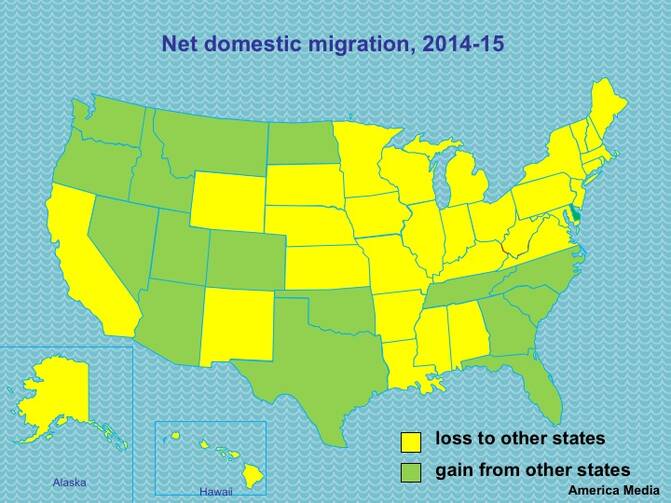Seven states lost population between July 2014 and July 2015, according to data released on Tuesday by the U.S. Census Bureau. Three are Democratic states in New England (Connecticut, Maine and Vermont), but the list also includes a big Democratic state in the Midwest (Illinois), a Democratic-leaning Western state (New Mexico), and two Republican states in the South (Mississippi and West Virginia). Ten years ago, the Census Bureau reported losses in only three states (Massachusetts, New York and Rhode Island) and the District of Columbia, but they have all bounced back somewhat, part of an overall pattern of faster growth in heavily urban areas.
Nine more states would have lost population between 2014 and 2015 if not for immigrants: Alaska, Maryland, Massachusetts, Michigan, New Jersey, New York, Ohio, Pennsylvania and Rhode Island. Except for Alaska, all voted for Democrat Barack Obama in the last presidential election. Reducing immigration to the United States would, in the long run, take Electoral College votes away from states that are now part of the Democratic base.
The fastest-growing state according to the latest estimate was North Dakota, whose population increased by 2.3 percent over a single year; this was the fourth year in a row that it took the top spot. Five other states, plus the District of Columbia, at least doubled the national growth rate of 0.79 percent: Colorado, Nevada, Florida, Texas and Utah. The first three are swing states in presidential elections, hard to predict precisely because they keep adding so many voters. Texas seems securely Republican for at least another decade. It had a net gain of 101,558 from immigrants, but it gained 170,103 from domestic migration, and the Americans moving there from other states probably lean to the right. Utah, one of the most Republican states, got most of its growth from a high birth rate.
Moving patterns were pretty lopsided. Only 17 states, plus the District of Columbia, attracted more people than they lost to other states. Besides Texas, the big gainers were Florida (a net increase of 202,510), Colorado (54,459) and Arizona (45,934). The states where the most residents packed up for greener pastures, and presumably cheaper homes, were New York (a net loss of 157,992), Illinois (-105.217) and California (-77,219).








